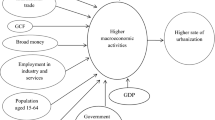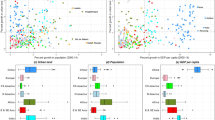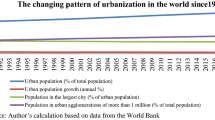Abstract
Recent urban population explosion in developing countries demands for several policy considerations. Is India ready for it? In this perspective, we assess the impact of economic reforms on urbanization in India for the period of 1991–2016. It is found that economic reform variables (except import of goods and services as % of GDP) have a positive effect on urbanization. The vector error correction model shows that economic reforms have influenced only on total urban population with a very slower rate with the speed of adjustment of 0.003. The short-run effect is also negligible. Granger causality test shows that there is no causal relationship between them. Therefore, we conclude that economic reforms do not promote urbanization in India. Our results also support the Krugman and Elizondo (J Dev Econ 49:137–150, 1996) hypothesis about the relationship between trade policy and urban agglomerations. Finally, we suggest that we need to promote urbanization through encouraging export for higher and sustainable economic growth in India.
Similar content being viewed by others
Notes
Data available from the following web link: https://data.worldbank.org/.
Here, the discussion on economic reforms is mainly derived from Ahluwalia (2002).
The coefficient of the error correction term is negative and statistically significant. Therefore, it is consistent with error correcting behavior. The bigger the (negative) statistically significant coefficient, more rapid is the correction. Desirable values of ECM should lie between − 1 to 0. The coefficient being negative (− 0.0027) and significant means that the system corrects its previous period disequilibrium at a speed of 0.27% and it indicates a very slow speed of adjustment of disequilibrium correction for reaching long run equilibrium steady state position.
Though Aristotle introduced a theory of causality, for the first time in human thought, but Clive W.J. Granger has proposed a first working definition of causality, which is called Granger causality in 1969. Hoover (2006) states that Granger-causality is the most influential approach to causality in economics. Recently, Sims (1972) provided a test of causality. However, one obvious limitation of Sims’ test is that it uses more regressors (due to inclusion of leading terms) and suffers from low degree of freedom. Therefore, we use Granger causality test for our analysis.
References
Abhishek N, Jenamani M, Mahanty B (2017) Urban growth in Indian cities: are the driving forces really changing? Habitat Int 69:48–57
Ades AF, Glaeser EL (1995) Trade and circuses: explaining urban giants. Q J Econ 110:195–227
Ahluwalia MS (2002) Economic reforms in India since 1991: has gradualism worked. J Econ Perspect 16(7):67–88
Ansari SJ, Rehmani A (2016) Economic reforms and its impact on the insurance industry in India. Int J Appl Res 2(4):121–124
Arltová M, Fedorová D (2016) Selection of unit root test on the basis of length of the time series and value of AR(1) parameter. Statistika 96(3):47–64
Bairoch P (1993) Economics and world history: myths and paradoxes. Chicago University Press, Chicago
Baldwin RE, Martin P (2004) Agglomeration and regional growth. In: Henderson VJ, Jacques-François T (eds) Handbook of regional and urban economics, vol. 4: cities and geography. Elsevier, North-Holland
Bhagat RB (2011) Emerging pattern of urbanisation in India. Econ Polit Weekly 46(34):10–12
Bhat TP (2011). Structural changes in India’s foreign trade. Working Paper, Institute for Studies in Industrial Development, New Delhi
Brülhart M, Sbergami F (2009) Agglomeration and growth: cross-country evidence. J Urban Econ 65:48–63
Cali M (2009) Urbanization, inequality, and economic growth: evidence from Indian states. Background Paper, World Development Report 2009, World Bank
Chadchan J, Shankar R (2012) An analysis of urban growth trends in the post-economic reforms period in India. Int J Sustainab Built Environ 1:36–49
Choudhuri B, Chatterjee B, Mazumdar M, Karim S (2017) Income ranking of Indian states and their pattern of urbanization. In: Denis E, Zerah MH (eds) Subaltern urbanization in India. Exploring urban change in South Asia. Springer, New Delhi
Dev SM, Mooij S (2002) Social sector expenditures in the 1990s analysis of central and state budgets. Econ Polit Weekly 37(9):853–866
Fujita M, Thisse J-F (2002) Economics of agglomeration: cities, industrial location, and regional growth. Cambridge University Press, Cambridge
Gangopadhyay S, Lanjouw P, Vishwanath T, Yoshida N (2010) Identifying pockets of poverty: insights from poverty mapping experiments in Andhra Pradesh, Orissa and West Bengal. Indian J Hum Dev 4(1):5–28
Gibson J, Datt G, Murgai R, Ravallion M (2017) For India’s rural poor, growing towns matter more than growing cities. World Bank 98:413–429
Gopinath S (2008) Development through planning, markets or decentralisation. Seminar Paper Presented at Indian Institute of Technology, Mumbai, January 21, 2008
Government of India (2009) India: urban poverty report 2009. Ministry of Housing and Urban Poverty Alleviation and Oxford University Press, New Delhi
Henderson JV (2003) The urbanization process and economic growth: the so-what question. J Econ Growth 8:47–71
Hohenberg PM (2004) The historical geography of European cities: an interpretative essay. In: Henderson JV, Jacques-François T (eds) Handbook of regional and urban economics, vol. 4: cities and geography. Elsevier, North-Holland
Hohenberg PM, Lees LH (1985) The making of urban Europe, 1000–1950. Harvard University Press, Harvard
Hoover Kevin D (2006) Causality in economics and econometrics. An entry for the new palgrave dictionary of economics. Palgrave Macmillan, New York
Johansen S (1988) Statistical analysis of cointegrating vectors. J Econ Dyn Control 12(2–3):231–254
Joshi S (2006) Impact of economic reforms on social sector expenditure in India. Econ Polit Weekly 41(4):358–365
Kalamkar SS (2009) Urbanization and agriculture growth in India. Indian J Agric Econ 64(3):442–461
Krugman P (1991) Increasing returns and economic geography. J Polit Econ 99:483–499
Krugman P, Elizondo RL (1996) Trade policy and third world metropolis. J Dev Econ 49:137–150
Kumar S, Sood A (2016) India’s foreign trade and balance of payments position in pre and post reforms period—an evaluation. J Econ Soc Dev 12(2):1–9
Kundu A (2006). Trends and patterns of urbanization and their economic implications. India Infrastructure Report 2006, Oxford University Press, New Delhi, Chap 2, pp 27–41
Lewis W Arthur (1954) Economic development with unlimited supplies of labor. Manch School Econ Soc Stud 22:139–191
Maheswari T (2017). Growth and structure of India’s foreign trade in the post-reform period www.indiastat.com. Accessed February–March
Marrocu E, Paci R, Usai S (2013) Productivity growth in the old and new europe: the role of agglomeration externalities. J Reg Sci 53:418–442
Martin P, Ottaviano G (1999) Growing locations: industry location in a model of endogenous growth. Eur Econ Rev 43:281–302
Mathur OP (2005) Impact of globalization on cities and city-related policies in India. In: Richardson HW, Bae C-HC (eds) Globalization and urban development. Springer, Berlin, pp 43–58
McKinsey Global Institute (2010): India’s urban awakening: building inclusive cities, sustaining economic growth. McKinsey Global Institute, San Francisco. www.mckinsey.com/mgi/publications/india_urbanization/index.asp. Accessed 5 Nov 2012
Mitra A (2014) Agglomeration economies and wellbeing: evidence from India. Athens J Health 1(1):23–36
Narayan L (2016) Relationship between urbanisation and economic growth: a causality analysis for India. Indian J Econ Dev 12(2):237–242
Nisa S, Nisa Z (2008) Economic reforms and its impact on developing countries—a case of India, SSRN. https://ssrn.com/abstract=1112583. http://doi.org/10.2139/ssrn.1112583. Accessed 2 Jan 2017
Nitsch V (2006) Trade openness and urban concentration: new evidence. J Econ Integr 21:340–362
Panchamukhi PR (2000) Social impact of economic reforms in india: a critical appraisal’. Econ Polit Weekly 35(10):836–847
Partridge MD, Rickman DS (2008) Distance From urban agglomeration economies and rural poverty. J Reg Sci 48:285–310
Pillania RK (2008) An exploratory study of Indian foreign trade. J Appl Econ Sci III 3(5):281–292
Prabhu KS (1994) The budget and structural adjustment with a human face. Econ Polit Weekly 29(16/17):1011–1028
Sahni P (2014) Trends in India’s exports: a comparative study of pre and post reform period. J Econ Finance 3(2):8–18
Sahu KK (2017) A comparative study of performance of india’s trade in pre and post liberalization period. Asian Reson 6(3):61–67
Sarkar P, Bhattacharyya B (2005) Trade liberalisation and growth: case studies of India and Korea. Econ Polit Wkly 40(53):5635–5641
Sharma M, Dhiman R (2014) Study of post—reform period of Indian exports: a review. Rev Bus Technol Res (RBTR) 11(1):1–9
Sims CA (1972) Money, income, and causality. Am Econ Rev 62:540–555
Singh AP (2014) Performance of foreign trade in India in the post-liberalization era. Int J Hum Soc Sci Educ 1(10):11–17
Sridhar KS (2010) Determinants of city growth and output in India. Rev Urban Reg Dev Stud 22:22–38
Thünen JH (1826) Der Isolierte Staat in Beziehung Auf Landwirtschaft Und Nationalökonomie. Hamburg, Perthes: Translated from German by Wartenberg, C. M. 1966, Von Thünen’s Isolated State. Pergamon Press, Oxford
Tripathi S (2013a) Do large agglomerations lead to economic growth? Evidence from urban India. Rev Urban Reg Dev Stud 25(3):176–200
Tripathi S (2013b) Does higher economic growth reduce poverty and increase inequality? Evidence from urban India. Indian J Hum Dev 7(1):109–137
Tripathi S (2015) An overview of India’s urbanization, urban economic growth and urban equity”. Int J Econ Empir Res 3(3):115–127
Tripathi S (2017) Relationship between Infrastructure and Population Agglomeration in Urban India: an empirical Assessment, Working paper no. 731, Asian Development Bank Institute, Japan
Tripathi S, Kaur S (2017) Do negative externalities have any impact on population agglomerations?. Evidence from Urban India, MPRA Paper No, p 76897
Tripathi S, Mahey K (2017) Urbanization and economic growth in Punjab (India): an empirical analysis. Urban Res Pract 10(4):379–402
Tripathi S, Rani C (2018) The impact of agricultural activities on urbanization: evidence and implications for India. Int J Urban Sci 22(1):123–144
Virmani A (2004). Economic reforms: policy and institutions some lessons from Indian reforms, Working Paper No. 121, Indian Council For Research On International Economic Relations, New Delhi. http://icrier.org/pdf/wp121.pdf. Accessed 10 Jan 2017
Williamson JG (1965) Regional inequality and the process of national development. Econ Dev Cult Change 13:3–45
World Bank (2010) Perspectives on poverty in india: stylized facts from survey data, India poverty assessment, poverty reduction and economic management network. The World Bank, Washington DC
Yadav P (2018) A comparative study of India’s foreign trade in pre and post reform era. Apeejay-J Manage Sci Technol 5(2):95–108
Author information
Authors and Affiliations
Corresponding author
Additional information
Publisher's Note
Springer Nature remains neutral with regard to jurisdictional claims in published maps and institutional affiliations.
About this article
Cite this article
Tripathi, S. Do economic reforms promote urbanization in India?. Asia-Pac J Reg Sci 3, 647–674 (2019). https://doi.org/10.1007/s41685-019-00117-8
Received:
Accepted:
Published:
Issue Date:
DOI: https://doi.org/10.1007/s41685-019-00117-8




